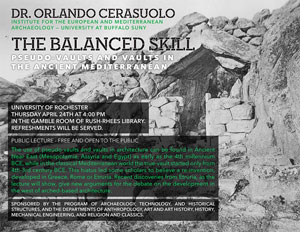"THE BALANCED SKILL: Pseudo Vaults and the Vaults in the Ancient Mediterranean"
Thursday, April 24, 2014
4 p.m.
Rush Rhees Library, Gamble Room

Lecture By
ORLANDO CERASUOLO
Institute for the European and
Mediterranean Archaeology
University at Buffalo SUNY
The use of pseudo-vaults and vaults in architecture can be found in Ancient Near East (Mesopotamia, Assyria and Egypt) as early as the 4th millennium BCE, while in the classical Mediterranean world the true vault started only from 4th 3rd century BCE. This hiatus led some scholars to believe a re invention, developed in Greece, Rome or Etruria. Recent discoveries from Etruria, as the lecture will show, give new arguments for the debate on the development in the west of arched based architecture.
Notwithstanding the earlier date derivable from literary sources (e.g. Seneca Epistol. 90,32), Greek and south Italian archaeological evidences start from 4th century BCE. Vaults can be found in gates (e.g. Cassope, Oiniadai, Velia, Paestum), tombs (Vergina) or other buildings (Corinth, Olimpia, Pergamon).
In Rome the first examples of vaults date back to the 6th century BCE (Palatine Hill), when ruled the Etruscan kings, and several others belong to the 4th century (Meta Sudans, S. Omobono). Some of the cities founded by the Romans after the conquest of Etruria have vaulted gates (Cosa, Falerii Novi), as well as the Roman Perugia and Volterra.
In Etruria vaulted buildings go back to the 4thG3rd century BCE (Cerveteri, Orvieto, Cortona) but some earlier experimental buildings are very significant. The earliest example of advanced building techniques can be seen at Populonia (8th century BCE). Later, pseudoGvaults with keyGbricks come from Veii (including the recent discovery of a cistern at Piazza d'Armi), Tarquinia and Orvieto, anticipating the Roman evidences and showing the skill of Etruscan craftsmen.
The Etruscan societies had strong links with the primary civilizations of the Mediterranean. Eastern craftsmen seem to have worked at the Etruscan cities. These long-range connections can explain the early Etruscan development of vault systems, which could have been seen as models by the republican Roman architects.
Sponsored By
PROGRAM OF ARCHAEOLOGY, TECHNOLOGY AND HISTORICAL STRUCTURES
DEPARTMENTS OF ANTHROPOLOGY, ART AND ART HISTORY, HISTORY,
MECHANICAL ENGINEERING and RELIGION AND CLASSICS
REFRESHMENTS WILL BE SERVED
